As the seasons change, so do our needs and the items we use regularly. Seasonal storage is an essential aspect of home organisation, allowing us to keep our living spaces clutter-free and ensuring that our belongings are stored safely and conveniently. By organising and storing items seasonally, we can create a more functional and enjoyable living environment.
Importance of Seasonal Storage
Seasonal storage helps us manage our possessions efficiently by rotating items based on the time of year. This approach not only saves space but also prolongs the life of our belongings by protecting them from unnecessary wear and exposure. Whether it’s storing winter clothes during the summer or tucking away holiday decorations, seasonal storage allows us to make the most of our space and resources.
Choose Self Storage Units in Wyong
Benefits of Organising Belongings Seasonally
Space Optimisation: By storing items that are not in use, we free up valuable space in our homes, making it easier to access and use what we need.
Protection of Belongings: Seasonal storage helps protect items from damage caused by temperature fluctuations, moisture, and pests, ensuring they remain in good condition for future use.
Improved Home Organisation: Organising belongings seasonally allows for a more streamlined and orderly living environment, reducing clutter and making it easier to find what we need when we need it.
Reduced Stress: A well-organised space can lead to a more relaxed and stress-free lifestyle, as it reduces the time and effort needed to maintain order and locate items.
Seasonal Storage Solutions: What to Store and When
1. Spring Cleaning and Storage
As the chill of winter fades and the warmth of spring begins to bloom, it’s the perfect time to declutter and organise your home. Spring cleaning is an ideal opportunity to store away winter items that are no longer needed, making room for lighter, seasonally appropriate belongings. Here’s a guide on what to store after winter, how to prepare these items for storage, and the best storage solutions to keep everything organised and protected.
Items to Store After Winter
Heavy Clothing: Coats, jackets, sweaters, scarves, gloves, and hats can take up significant space in your closet. Storing these items until next winter will free up room for spring and summer attire.
Winter Sports Gear: Skis, snowboards, ice skates, and other winter sports equipment should be stored away until the next season to prevent unnecessary wear and tear.
Holiday Decorations: Christmas lights, ornaments, and other festive decorations can be safely packed away, allowing you to focus on spring-themed decor.
Winter Bedding: Heavy blankets, comforters, and flannel sheets can be stored, making space for lighter bedding suitable for warmer weather.
2. Summer Storage Tips
As the warmth of summer settles in, it’s time to transition your living spaces to accommodate the season’s needs. Storing away winter items and making summer gear easily accessible can help you enjoy the sunny days without unnecessary clutter. Here’s a guide on what to store during the summer, how to prepare your summer gear for easy access, and the best storage options for your items.
What to Store During the Summer
During the summer, it’s wise to store away items that are primarily used in the colder months. This includes heavy blankets, winter boots, and other cold-weather clothing. These items can take up valuable space and aren’t needed during the warmer season. Storing them properly will not only free up space but also protect them from dust, pests, and potential damage. Additionally, consider storing holiday decorations, snow shovels, and any winter sports equipment you may have missed during your spring cleaning.
Preparing Summer Gear for Easy Access
Summer is a time for outdoor activities, so it’s important to have your summer gear ready and accessible. This includes camping equipment, beach gear, bicycles, and outdoor furniture. Before using these items, give them a thorough cleaning and inspection. Check tents and sleeping bags for tears, clean and oil bikes, and wash down outdoor furniture. Organise these items in a way that makes them easy to grab when you’re ready for an adventure. For instance, keep camping gear together in labelled bins or store beach gear in a dedicated area of your garage or shed.
3. Fall Organisation and Storage
As the days grow shorter and the air turns crisp, it’s time to prepare your home for the cooler months ahead. Fall is a transitional season, perfect for storing summer items and bringing out your cold-weather essentials. Organising your belongings during this time can help ensure a smooth transition into winter and keep your home tidy and functional. Here’s how to manage this seasonal shift effectively.
Items to Store After Summer
As summer comes to an end, it’s time to pack away items that won’t be needed until next year. This includes summer clothes, beach gear, outdoor furniture, and sports equipment like surfboards or pool toys. Proper storage will protect these items from the elements and ensure they’re ready for use when warm weather returns. Clean and dry all items thoroughly before storing them to prevent mould, mildew, and damage. For clothing, consider using vacuum-sealed bags to save space and protect fabrics. Store beach gear and outdoor furniture in a garage, shed, or self-storage unit, ensuring they are covered or wrapped to prevent dust and moisture buildup.
Tips for Transitioning to Colder Weather Items
With the arrival of cooler weather, it’s time to transition your wardrobe and home essentials to accommodate the change. Start by bringing out sweaters, boots, coats, and other cold-weather clothing. Check each item for cleanliness and repairs before placing them in your closet. If you find any items in need of mending or cleaning, address these issues promptly. Rotate your wardrobe by placing summer clothes and lighter items towards the back of your closet or in storage bins, making space for bulkier, warmer garments.
In addition to clothing, consider swapping out lighter bedding for heavier blankets and comforters. It’s also a good time to bring out any seasonal gear, like space heaters, humidifiers, or additional insulation materials for windows and doors.
4. Winter Storage Solutions
As winter approaches, it’s time to prepare your home and belongings for the colder months ahead. Storing away items that won’t be used during winter, such as garden tools, patio furniture, and summer recreational gear, can help protect them from the elements and extend their lifespan. Make sure to clean and dry these items thoroughly before storing them to prevent rust, mould, and other damage. Use protective covers for larger items like patio furniture and consider storing them in a garage, shed, or self-storage unit to keep them safe from winter weather.
Additionally, winter is a time for festive celebrations, and proper storage of holiday decorations and seasonal items is essential. Whether you’re packing away Christmas trees, Hanukkah decorations, or other holiday decor, use sturdy, labelled boxes or bins to keep everything organised and easily accessible for the next season. For delicate ornaments, use padding or compartmentalised storage containers to prevent breakage. Store your holiday decorations in a cool, dry place to maintain their condition, and consider keeping frequently used items closer to the front of your storage area for easy access during the holiday season.
5. Year-Round Storage Tips
Maintaining an organised and efficient storage system throughout the year requires thoughtful planning and management. Implementing a rotating storage schedule, effective labelling and inventory management, and choosing the right type of storage can help keep your belongings safe and accessible, regardless of the season.
Creating a Rotating Storage Schedule
A rotating storage schedule involves periodically reviewing and updating your stored items based on seasonal needs. This approach ensures that items are only stored when necessary, reducing clutter and making it easier to access what you need. At the start of each season, take the time to switch out seasonal items, storing those that are out of season and bringing out those that will be used. This not only optimises space but also helps you stay organised by keeping your living areas free from unnecessary items.
Labelling and Inventory Management
Effective labelling and inventory management are crucial for keeping track of stored items. Clearly label each box or bin with its contents and the season or category it belongs to. This can include simple descriptions like “Winter Coats” or more detailed lists if the box contains multiple types of items. Additionally, consider creating an inventory list for your storage area, detailing the contents of each box and their location. This list can be digital or physical, and it will help you quickly find specific items without having to rummage through multiple boxes. Keeping an inventory also helps you keep track of what you own, reducing the risk of purchasing duplicates.
Conclusion
Organising your belongings seasonally not only optimises your living space but also helps protect and preserve your items throughout the year. By creating a rotating storage schedule, effectively labelling and managing your inventory, and choosing the right type of storage, you can maintain an organised and efficient home. Now is the perfect time to start implementing these seasonal storage strategies, making each transition smoother and more manageable. Embrace the benefits of seasonal organisation and enjoy a clutter-free and well-organised home all year round!
If you’re seeking a reliable storage solution in Wyong, choose Simply Storage Wyong. Our facility offers secure, convenient, and tailored options to meet all your storage needs, ensuring peace of mind and easy access to your belongings.


